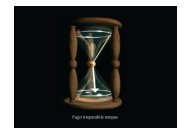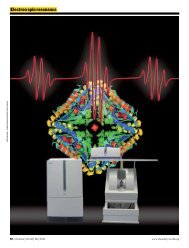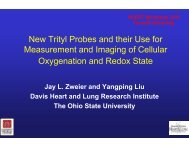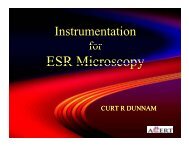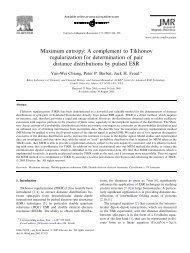Presentation - acert - Cornell University
Presentation - acert - Cornell University
Presentation - acert - Cornell University
You also want an ePaper? Increase the reach of your titles
YUMPU automatically turns print PDFs into web optimized ePapers that Google loves.
ISMAR & JHF<br />
Jack H. Freed<br />
Dept. of Chemistry and Chemical Biology<br />
<strong>Cornell</strong> <strong>University</strong><br />
Ithaca, New York 14853 USA
ISMAR MEETINGS<br />
‐ 1st Conference, 1962 (1965)‐ Tokyo, Japan<br />
‐ 2nd Conference, 1965 (1968)‐ Sao Paulo, Brazil<br />
‐ 3rd Conference, 1968 (1969)‐ Melbourne, Australia<br />
* 4th Conference, 1971‐ Rehovot/Jerusalem, Israel<br />
^ 5th Conference, 1974 ‐ Bombay, India<br />
* 6th Conference, 1977 ‐ Banff, Alberta, Canada<br />
* 7th Conference, 1980 ‐ Delft, The Netherlands<br />
* 8th Conference, 1983 ‐ Chicago, Illinois USA<br />
‐ 9th Conference, 1986 ‐ Rio de Janeiro, Brazil<br />
* 10th Conference, 1989 ‐ Morzine, France<br />
* 11th Conference, 1992 ‐ Vancouver, Canada<br />
* 12th Conference, 1995 ‐ Sydney Australia<br />
* 13th Conference, 1998 ‐ Berlin, Germany<br />
* 14th Conference, 2001 ‐ Greek island of Rhodes<br />
* 15th Conference, 2004 ‐ Jacksonville, Florida USA<br />
* 16th Conference, 2007 ‐ Kenting, Taiwan<br />
* 17th Conference, 2010 ‐ Florence, Italy<br />
* 18th Conference, 2013 ‐ Rio de Janeiro, Brazil<br />
* Meetings attended by JHF ^ TBD
1962: ISMAR: Tokyo, JAPAN<br />
JHF: Receives Ph.D., Columbia <strong>University</strong> with G. K. Fraenkel<br />
Ph.D. Thesis: A Study of Hyperfine Linewidths in ESR Spectra<br />
Alternating Linewidth ‐ Spectrum of para‐dinotrodurene anion radical<br />
in 20C DMF<br />
Asymmetric<br />
Linewidth<br />
Variation<br />
Spectrum of paradinotrobenzene<br />
anion radical<br />
‐55C DMF<br />
Alternating LW’s : Outof‐phase<br />
correlation<br />
between the HF<br />
splittings of the two<br />
nitroxides in DND led to<br />
Equivalent Nuclei on<br />
Avg. vs. Completely<br />
Equivalent Nuclei.<br />
Terms in the<br />
perturbation H 1 (t). a<br />
Necessitated New Paradigm for HF<br />
Linewidths in Organic Radicals:<br />
Freed – Fraenkel Theory:<br />
Used Redfield Relaxation Matrix Based on WBR<br />
(Wangsness‐Bloch‐Redfield Theory) includes Degenerate<br />
HF Transitions. (JCP, 39, 326‐48, 1963)
1965: ISMAR: San Paulo, Brazil<br />
JHF: Assistant Professor, <strong>Cornell</strong> <strong>University</strong><br />
Theory of ESR Saturation and Double Resonance<br />
in Organic Free Radicals in Solution<br />
ENDOR in Solution<br />
Hyde & Maki, JCP 40, 3117 (1964)<br />
Limiting Case of ENDOR from Theory<br />
Freed, JCP 43, 2312 (1965)<br />
*<br />
More General Application Of Redfield (WBR) Theory Leads To Coupled<br />
Solution In Matrix Form For The Many ESR Transitions In<br />
The Spectrum With Some Undergoing Saturation: Saturation Parameters Ωe,n
1968 ISMAR: Melbourne, Australia<br />
JHF: Associate Professor, <strong>Cornell</strong> <strong>University</strong><br />
Electron‐Electron Double Resonance (ELDOR)<br />
with J. S. Hyde, J.C.W. Chien, JCP 48, 4211 (1968)<br />
* Pump One Hyperfine Line and Observe Effect on Another HF Line<br />
EPR:<br />
Pump Off<br />
Bimodal Cavity<br />
EPR:<br />
Pump On<br />
ELDOR:<br />
(a) – (b)<br />
Nitroxide radical in ethybenzene, ‐80°C<br />
Nitroxide<br />
Radical<br />
Reduction factor, R, for strongly saturated<br />
observing transition. b = W n / W e<br />
General Saturation &<br />
Double Res. Theory:<br />
ELDOR Reductions Depend<br />
on o,p × p,o the Cross‐<br />
Saturation Parameters<br />
Between Observing and<br />
Pumped Transitions
1968 Cont.<br />
Generalized Cumulant Expansions (GCE)<br />
and Spin‐Relation Theory (JCP 49 376 (1968))<br />
1. How to deal with breakdown<br />
of WBR Theory<br />
Based on GCE method<br />
of Kubo.<br />
2. Leads to Relaxation<br />
Matrix to all orders:<br />
<br />
<br />
<br />
for t ≫ τ c<br />
of order<br />
<br />
with R (n)<br />
† () n n 1<br />
1<br />
t <br />
c<br />
3. This is a Complex<br />
Expansion in powers<br />
of<br />
<br />
†<br />
1 () t <br />
c<br />
4. Also shows how to<br />
introduce “finite<br />
time” corrections<br />
when τ c ≳ t .
1971 ISMAR: Jerusalem, Israel<br />
JHF: Attends (part of) ISMAR<br />
The Stochastic Liouville Equation (SLE) and Slow Motional<br />
ESR (with G. Bruno and C.F. Polnaszek, JPC 75, 3385 (1971) )<br />
<br />
i<br />
t<br />
ρ : Spin Density Matrix<br />
H(t): Random Hamiltonian<br />
<br />
P(, t) : Probability of finding at t .<br />
time independent Markoff<br />
Operator.<br />
Leads to SLE:<br />
H(),<br />
t <br />
<br />
P( , t) = P( , t)<br />
t<br />
ρ(,t): Joint Spin Density Matrix<br />
As Well As Classical Probability<br />
Density in .<br />
<br />
<br />
<br />
Kubo (1969) showed<br />
this with heuristic<br />
argument.<br />
Freed (1972) showed<br />
this with generalized<br />
moment expansion.<br />
Hwang & Freed (1975)<br />
developed this by<br />
passing to semiclassical<br />
limit from<br />
quantum stat. mech.<br />
Leads to a “spin‐force”<br />
and/or “spin‐torque”<br />
back‐reaction of spins<br />
on bath. Confirms high<br />
T limit.<br />
Wassam & Freed (1982)<br />
developed this from<br />
even more general<br />
many‐body quantum<br />
stat. mech.<br />
Incipient<br />
Slow Motion<br />
Very<br />
Slow<br />
Motion<br />
ABSORPTION<br />
Slow Motion<br />
Very<br />
Slow<br />
Motion<br />
Incipient<br />
Slow Motion<br />
Slow Motion<br />
DERIVATIVE<br />
Line Shapes for S= ½, I= 1 ( 14 N nucleus) with axially<br />
symmetric g tensor, hyperfine tensor, and small ω n.<br />
PADS in Frozen<br />
D 2 O at ‐65°C. S. A Goldman<br />
Very Slow Motion<br />
‐‐‐ Experimental<br />
Calculated for Brownian<br />
Diffusion<br />
‐<br />
O 3 S<br />
O<br />
N<br />
SO 3<br />
‐<br />
[K + ] 2
1974 : ISMAR: Bombay, India<br />
JHF: Did not receive letter from India with invitation to deliver plenary lecture.<br />
Studies of Electron Spin Relaxation of Nitroxide Probes in Solution: Fast<br />
& Slow Motions and Search for a Model, (with J. Hwang, R. Mason and L.‐P.<br />
Hwang, JPC 79, 489 (1975))<br />
PD‐Tempone<br />
Comparison of<br />
experiment<br />
and simulated<br />
spectra in the<br />
modeldependent<br />
slow‐tumbling<br />
region for PD‐<br />
Tempone in<br />
toluene‐d 8<br />
Brownian vs. Jump<br />
Diffusion: Slow<br />
Motional Fits.<br />
τ R vs. η/T over five orders of magnitude<br />
Non‐secular spectral densities:<br />
j(ω)≈ τ R /[1+ε 2 τ R2 ] ‐1 , ε >1<br />
W e vs. τ R in<br />
various solvents<br />
Fluctuating<br />
Torques (Fast Bath<br />
Modes) vs. Slowly<br />
Relaxing<br />
Structures (Slow<br />
Bath Modes)
1977: ISMAR: Banff, Canada<br />
JHF: Lectures<br />
ESR and Spin Relaxation in Liquid Crystals (with C.F. Polnaszek,<br />
JPC 79 2282, (1975))<br />
Liquid Crystals Yield an Anisotropic<br />
Environment:<br />
P ( ) exp( U( o<br />
)/kT) d exp( U( )/kT)<br />
U() : Anistropic Potential<br />
A challenge to diagonalization: Leads to nonsymmetric<br />
matrices. Render symmetric by<br />
similarity transformation:<br />
<br />
1/2<br />
P( ,t) P 0( ) P( ,t)<br />
<br />
Symmetrized Diffusion Operator:<br />
MRMU TRT<br />
MRM+<br />
<br />
2<br />
2κT (2κT)<br />
M: Vector Operator which generates an<br />
infinitesimal Rotation.<br />
T ≡ iMU() is the external torque derived<br />
from the potential U().<br />
Yielding:<br />
P<br />
t<br />
P( ,t)<br />
<br />
Comparison of experimental (‐‐‐‐‐)<br />
and theoretical ( ) spectra for PD‐<br />
Tempone in Phase V stresses the need<br />
for SRLS model.
1977 Cont.<br />
10kbar<br />
maximum<br />
High Pressure (J.S. Hwang and K.V.S. Rao, JPC 80, 1490 (1976))<br />
More evidence for SRLS from High Pressure Experiments<br />
Graph of τ R vs. pressure for PD<br />
Tempone in phase V.<br />
Comparison of experimental and simulated spectra<br />
at 45°C for PD‐Tempone in Phase V (a) 3450 bars<br />
(b)4031 bars ( ‐‐‐‐) experimental results; (∙ ‐ ∙ ‐ ∙) and<br />
( ) theoretical results for different models.<br />
Slow‐<br />
Wave<br />
Helix<br />
ESR High Pressure Vessel<br />
(Hydraulic)<br />
General Theoretical Analysis Led to Expressions for SRLS<br />
Spectral Density (JCP, 66, 483 (1977):<br />
Where τ R<br />
’‐1<br />
= τ R<br />
‐1<br />
+<br />
τ x<br />
‐1<br />
and κ=1/5 for<br />
isotropic<br />
medium. Later<br />
referred to as<br />
“Model Free”<br />
expression.
1980 ISMAR : Delft, Netherlands<br />
JHF: In attendance, but barred from presenting.<br />
Efficient Computation of ESR Spectra and Related Fokker‐Planck<br />
Forms by the Use of the Lanczos Algorithm (LA)<br />
Spectrum from SLE:<br />
(with Giorgio Moro, JCP 74 , 3757 (1981))<br />
1<br />
1<br />
I( ) Re{ [i1 L<br />
] }<br />
<br />
L ‐ Liouville operator associated with spin<br />
Hamiltonian<br />
‐ Symmetrical diffusion operator<br />
ν> ‐ Vector of allowed spectral components<br />
The Lanczos algorithm : Let ≡L<br />
By operating with A n times on ν> and<br />
simple rearranging, an n‐dimensional<br />
orthonormal sub‐set of the N >> n total<br />
basis set is obtained such that A n is tridiagonal<br />
with A n = P n AP n<br />
‐1<br />
where P n<br />
projects out the “Relevant Sub‐Space.”<br />
This was the first significant<br />
application of the LA to Complex<br />
Symmetric (non‐Hermitian)<br />
Matrices.<br />
Leads to Order(s) of Magnitude<br />
Reduction in Computer Space<br />
&Time.<br />
Distribution of the<br />
eigenvalues for<br />
calculation. Units<br />
are in G; x & y axis<br />
represent real &<br />
imaginary parts of<br />
the eigenvalues.<br />
from Lanczos<br />
algorithm; exact.<br />
Derivative<br />
spectrum for<br />
nonaxial g<br />
tensor<br />
Behavior of<br />
the logarithm<br />
of the error<br />
Lanczos Steps rapidly converge to solution
1980 cont.<br />
<br />
<br />
The computational algorithm is<br />
formally equivalent to the Mori<br />
Method in Statistical Mechanics:<br />
i.e. in projecting out the relevant<br />
sub‐space:<br />
But in the Mori method, general<br />
arguments are given for the manybody<br />
problem, while we used the<br />
SLE approximation to the manybody<br />
problem but with a welldefined<br />
computational<br />
methodology.<br />
General Conclusion:<br />
The Quantum World with its<br />
Microscopic Reversibility is<br />
Represented by Unitary Space.<br />
But the Real World with its<br />
Irreversibility is Properly<br />
Represented by (complex) –<br />
Orthogonal Space.<br />
Suppose one starts with an arbitrary<br />
matrix representation with both<br />
coherence and damping: M<br />
THEOREM:<br />
Equivalent to a complex symmetric matrix<br />
through a similarity transformation:<br />
A=SMS ‐1 i.e. where A is complex<br />
symmetric and S UH where H is<br />
Hermitian and U is Unitary.<br />
This we accomplish with a diagonal<br />
Hermitian Matrix: P 1/2 o<br />
( )<br />
and U→ Transforms the basis set to be<br />
time reversal invariant. Then both L and Γ<br />
are represented by real symmetric matrices.<br />
(cf. D. Schneider and J.H.F. 1989).<br />
This methodology permitted calculating<br />
ESR spectra for smectic liquid crystals<br />
where the normal to the smectic planes is<br />
tilted relative to the magnetic field<br />
destroying the cylindrical symmetry.
1983 ISMAR: Chicago<br />
JHF: Lectures<br />
Nuclear Spin Waves in (Doubly) Spin‐Polarized Atomic Hydrogen Gas<br />
(with B.R. Johnson, J.S. Denker, N. Bigelow, L.P. Levy, D.M. Lee, PRL 52, 1508, 1984 )<br />
Spin‐polarized H↓ is a gas of atomic hydrogen with the electron<br />
spins aligned by cooling the H atoms to T ˂ 0.5K in a magnetic<br />
field H = 8 – 10 Tesla. Thus pairwise collisions of pure H ↓ atoms<br />
cannot recombine due to the Pauli Exclusion Principle (S = 1).<br />
d > = ><br />
c > = > + ε ><br />
b > = ><br />
a> = > ε ><br />
Schematic Diagram of cryostat<br />
& atomic hydrogen source<br />
H Atom Energy<br />
Levels<br />
W= 10K at 8T<br />
The sample cell with “loopgap”<br />
or split ring resonator.<br />
Surfaces coated with saturated<br />
film of superfluid 4 He.<br />
Yet it is nearly an ideal gas: PV = nRT ! as well as a<br />
gas of Bosons.<br />
But nuclear spin polarization requires T ˂ 30 mK at 10<br />
Tesla. Thus both ground state a˃ and next state b˃<br />
are initially populated.<br />
But a> is not a pure state:<br />
a > = > ε > ε = a/2γ e B 0<br />
At 10 Tesla ε ≅ 2.5 x 10 ‐3<br />
This provides a recombination pathway.<br />
In time, only the b > = > state remains a pure<br />
state of doubly spin‐polarized H↓ ↓<br />
For 10 16 –10 17 atoms/cm 3<br />
Nuclear T 1 ~ hours<br />
Recombination times for a > ~ 2 – 10 min.<br />
Lengths:<br />
S‐wave scattering length between 2H↓ atoms: a s ≅ 0.72Å<br />
thermal de Broglie wavelength λ T ≅ 20‐50Å<br />
spin‐wave wavelength λ ~ 0.1 – 1.0 cm<br />
sample size L = 0.6 X 1.0 cm.
1983 Cont.<br />
FT‐NMR spectra for H<br />
at 2 temperatures<br />
Spin Waves due to apparent nuclear‐spin‐dependent<br />
collision cross‐section of H . This is an effect of the Bose<br />
statistics on the nuclear degrees of freedom. True interaction<br />
potential is just that of the electron‐spin triplet potential<br />
energy curve.<br />
For small tipping angles:<br />
Quality factor:<br />
μ = a<br />
<br />
ε = 1 for Bosons<br />
is complex effective diffusion<br />
coefficient<br />
P is nuclear spin polarization with components P + & P z<br />
T<br />
s<br />
n=3.6x10 16 cm ‐3<br />
T=245mK<br />
n=3.2x10 16 cm ‐3<br />
In absence of gradient: simple<br />
standing waves.<br />
With gradient: Can solve for the<br />
complex eigenvalues: Airy Fns.<br />
The act of using a field gradient<br />
to image the spin waves traps<br />
the modes by the<br />
“linear potential well”<br />
FT‐NMR spectra for H<br />
at 2 gradients. b) larger<br />
gradient than a)<br />
Find P z = 0.9 ± 0.1<br />
μT 1/2 = 3.5 ± 0.4 (Thy: 3.65)<br />
nD o = 1.3 X 10 18 cm ‐1 sec ‐1<br />
(Thy: 1.5 X 10 18 cm ‐1 sec. ‐1 )<br />
μP< 0 μP > 0
1986 ISMAR: Rio de Janiero<br />
JHF: Did not attend<br />
Two‐Dimensional Fourier<br />
Transform ESR: 2D‐ELDOR<br />
(with Jeff Gorcester,<br />
JCP 85, 5375 (1986); 88, 4678 (1988).)<br />
Absolute Value<br />
2‐D ELDOR of<br />
PD‐tempone in<br />
toluene‐d8 at<br />
21°C.<br />
T mix = 3 10 ‐7 s.<br />
Cross‐peaks due<br />
to Heisenberg<br />
Spin Exchange.<br />
Quadrature<br />
Mixer<br />
DC Block<br />
Isolator<br />
Spectrum after<br />
LPSVD: Pure<br />
2D‐ Absorption<br />
representation.<br />
Modulator<br />
GaAsFET<br />
Pre‐Amplifier<br />
TWT Amplifier<br />
Pin Diode Limiter<br />
2D‐FT‐ESR Spectrometer Block Diagram<br />
2D‐ELDOR<br />
pulse<br />
sequence:<br />
3 /2 pulses
1986 cont.<br />
Ultra‐High Vacuum ESR<br />
(with P.G. Barkley and J.P. Hornak,<br />
JCP 84, 1886 (1986)) at 10 ‐10 Torr<br />
Ti Sublimation<br />
Pump<br />
Mass<br />
Analyzer<br />
Cavity<br />
UHV‐ESR Microwave Cavity<br />
Q u ≈ 13,000, TE011 resonator<br />
mode. 50 cm 2 surface area<br />
UHV<br />
Microwave<br />
Feed Thru<br />
Ion<br />
Pump<br />
Evaporator<br />
Assembly<br />
Magnet<br />
Ion Gauge<br />
UV‐ESR System<br />
In no case does an ESR signal<br />
appear when the nitroxide is<br />
first put down on clean Ag or Cu<br />
or on the metal pretreated with<br />
O 2 (and H 2 O). Some minimum<br />
dosage is required for ESR<br />
signal to be detectable: SSERS<br />
(Surface Suppressed Electron<br />
Resonance Spectroscopies).<br />
Desorption 1<br />
ESR<br />
Desorption 2<br />
Thermal<br />
Desorption<br />
Plus ESR<br />
Experiment
1989 ISMAR: Morzine, France<br />
JHF: Plenary Lecture<br />
Fabry‐Perot cavity<br />
M indicates mirror<br />
assembly<br />
1mm ESR sample holder<br />
for low loss samples<br />
ESR Spectroscopy at 1 MM Wavelengths:<br />
FIR‐ESR (with B. Lynch & K. Earle,<br />
Rev. Sci. Instrum. 59, 1345, (1988))<br />
Quasi‐Optical Reflection Bridge<br />
1996 (with* K.A. Earle & D.S.<br />
Tipikin, RSI, 67, 2502)<br />
Significant Increase in S/N<br />
ESR Spectra of<br />
PD‐Tempone at<br />
250 & 95GHz in<br />
solvents of<br />
increasing<br />
viscosity (a‐e).<br />
*A motionally<br />
narrowed<br />
spectrum at<br />
9 GHz looks<br />
slow motional<br />
at 250 GHz.<br />
Detector<br />
Paraboloidal<br />
Focusing<br />
Mirror<br />
Focusing<br />
Lens<br />
Flat Mirror<br />
Fabry Perot<br />
Resonator<br />
Coupling Mesh<br />
Corrugated<br />
Wave‐Guide<br />
Polarization<br />
Transforming<br />
Reflector<br />
Duplexing<br />
Grid<br />
Gaussian<br />
Beam Two‐<br />
Mirror<br />
Telescope<br />
Block diagram of 1‐mm ESR<br />
transmission spectrometer at 9T. using<br />
250 GHz quasi‐optical waveguide<br />
(OptiguideTM) & 500G‐sweep coils.<br />
Source<br />
Coupling<br />
Lens<br />
Paraboloidal<br />
Focusing Mirror
1992 ISMAR: Vancouver, Canada<br />
JHF: Lectured<br />
Diffusion Coefficients in Anisotropic Fluids by ESR Imaging of Concentration<br />
Profiles: DID‐ESR (with J.P. Hornak, J.K. Moscicki, D.J. Schneider, Y.K. Shin,<br />
Reviewed : Annu. Rev. Biophys. 23, 1 (1994))<br />
Concentration<br />
Profiles for<br />
Tempone<br />
diffusing in<br />
the nematic<br />
phase of 5,4 at<br />
300K at<br />
increasing<br />
times.<br />
Using 1D field gradients<br />
& cw‐ESR accurate<br />
translational diffusion<br />
coefficients ranging from<br />
10 ‐5 to 10 ‐9 cm 2 /s were<br />
measured in isotropic &<br />
anisotropic fluids.<br />
Sample Preparation<br />
Hi T<br />
D ,PDT<br />
D D =<br />
1.41± 0.1<br />
Nematic<br />
D ,PDT<br />
D ,CSL<br />
Lo T<br />
ISOTROPIC/NEMATIC<br />
LIQUIDS:<br />
D to Nematic Director.<br />
D to Nematic Director<br />
D ,CSL<br />
Smectic Liquid Crystal, S2<br />
Small Probe: PDT D D > 1<br />
Large Probe: CSL D D < 1<br />
Lateral diffusion of CSL( )<br />
And 16PC )in<br />
phospholipid POPC vs.<br />
cholesterol m.f. at different<br />
temperatures
1995: ISMAR: Sidney, Australia<br />
JHF: Session Chm.; Lectured in ESR Satellite<br />
S c‐<br />
2D‐ELDOR & Slow Motions<br />
(with S. Lee, B.R. Patyal, S. Saxena,R.H. Crepeau<br />
CPL 221, 397 (1994)) with SRLS Analysis<br />
(with A. Polimeno, JPC, 99, 10995 (1995))<br />
The experimental technology for 2D‐ELDOR had<br />
progressed substantially and the detailed theory based on<br />
the SLE was fully developed along with NLLS analysis.<br />
S c+<br />
By obtaining 2D‐ELDOR spectra at 6‐8 different mixing<br />
times → actually a 3rd dimension to the experiment.<br />
Time Domain in 2D‐ELDOR Spectra<br />
We found the spin‐relaxation and motional dynamics information is very<br />
extensive. Simple motional models could not fit data very well, so we<br />
applied the SRLS model with considerable success:<br />
In a complex fluid, one expects the molecular reorientation to be non‐<br />
Markovian. It is modeled in SRLS by both the Smoluchowski‐type<br />
diffusive rotation of the probe in a mean potential, and the diffusive<br />
operator for the reorientation of the local structure (the cage) formed by the<br />
molecules in the immediate surroundings of the probe.<br />
Their collective motion constitutes a multi‐dimensional Markov process.<br />
Reference<br />
Frames<br />
for SRLS<br />
LF –Lab Frame<br />
DF – Director Frame<br />
MF – Molecular Frame<br />
CF – Cage Frame<br />
GF –g‐tensor Frame<br />
AF –A tensor Frame
1995 cont.<br />
Multitude of Relaxation and Dynamic Data<br />
Optimum parameters obtained from fits to the SRLS Model (10 Such Parameters)<br />
T m =110 ns<br />
T m =250 ns<br />
CSL in Macroscopically Aligned<br />
Smectic A phase of<br />
Liquid Crystal 40.8 (59°C).<br />
(V.S.S. Sastry, et al., JCP 105, 5753 (1996))<br />
CSL In Liquid<br />
Crystalline Polymer<br />
D. Xu et al. (JPC 1001,<br />
15873 (1996)
1998: ISMAR: Berlin, Germany<br />
JHF: Lectured<br />
250 GHz Studies of<br />
Molecular Dynamics<br />
1) Dynamic Cage Effects<br />
Above the Glass Transition<br />
(with K. Earle, J.K.<br />
Moscicki, A. Polimeno, JCP,<br />
106, 9996, (1997))<br />
Experimental ESR<br />
spectra taken at<br />
250GHz covering the<br />
entire temperature<br />
range of liquid to<br />
glassy behavior:<br />
(a)PDT; (b) MOTA; and<br />
(c) CSL.<br />
PDT<br />
MOTA<br />
CSL<br />
OTP<br />
Solvent<br />
MOTA<br />
PDT<br />
CSL<br />
OTP Cage<br />
Rotational Diffusion Rates for Probes<br />
dependent upon their size.<br />
Relaxation of cage is the same<br />
for all the probes.<br />
Cage potential parameters below T M depend on size<br />
and shape of probe; above T M they all are zero.
2001: ISMAR: Rhodes<br />
JHF: Lectured; ACERT is initiated.<br />
Protein Structure Determination Using Long‐Distance Constraints from<br />
Double‐Quantum Coherence (DQC) ESR: T4–Lysozyme<br />
(with Peter Borbat* & H.S. Mchaourab , JACS 124, 5304 (2002))<br />
DQC‐ESR Pulse Sequence<br />
/2 pulses = 3.2 ns<br />
pulses = 6.4 ns<br />
T4L<br />
Triangulation<br />
Left: Time evolution of DQC Signal from<br />
doubly labeled T4L; Right : their FT’s<br />
Accounting for Flexibility<br />
of Tether
2001 Cont.<br />
Dipolar Relaxation in a Many‐Body System of Spins of ½:<br />
Translation Diffusion (with A.A. Nevzorov, JCP, 112, 1425 (2000); 115, 2401<br />
(2001))<br />
Homogeneous R 2<br />
Bridging the two limits vs. relative translational<br />
diffusion coefficient D T
2004 ISMAR: Jacksonville, FL (USA)<br />
JHF: Plenary Lecture<br />
95 GHzHigh‐Power Quasi‐Optical Pulsed ESR<br />
Spectrometer (with* W. Hofbauer, K.A. Earle,<br />
C.R. Dunnam, J.K. Moscicki, RSI 75, 1194 (2004))<br />
Block Diagram of Transceiver<br />
5ns ⁄ pulse ≅ 18 G.<br />
Spectral bandwidth<br />
175 MHz ( or 62 G.)<br />
Spectrometer Block Diagram<br />
Schematic<br />
Diagram<br />
of Quasi‐<br />
Optical<br />
Bridge<br />
Based on<br />
Polarizati<br />
on<br />
Coding:<br />
Induction<br />
Mode.<br />
Exp’t.<br />
Simulated<br />
2‐D ELDOR,<br />
Sc‐ Spectra<br />
of Tempo in<br />
90%<br />
water/10%<br />
glycerol,<br />
22°C at<br />
various<br />
mixing<br />
times.<br />
New relaxation mechanism ineffective at lower fields & frequencies. e.g.<br />
dynamic modulation of the g‐value due to rapid solvent‐induced fluctuations.
2004 Cont.<br />
Electron Spin Resonance Microscopy: Micron Resolution (with<br />
A. Blank*, C.R. Dunnam, P.P. Borbat, RSI 75, 3050; APL 85, 5430 (2004))<br />
Photo of Pulsed Imaging Probe<br />
Calculated Microwave H 1 & E 1 fields<br />
for High Permitivity Resonator<br />
CW Imaging Probe Layout<br />
75 T/m (Recent)<br />
47 T/m (Recent)<br />
1.3 T/m<br />
Typical Pulse<br />
Imaging<br />
Sequence<br />
Imaging Mouse<br />
Leg Tissue with<br />
tumor (2010)<br />
Block<br />
Diagram<br />
of the<br />
Pulsed<br />
Imaging<br />
System<br />
= 925 ns 1025ns 1125ns<br />
LiPc crystal size of 55 X 67 X 15 μm<br />
Recent ESRM ~ 0.7 X 0.75 X 7.5 μm<br />
Amplitude Map T 2<br />
Map
2007: ISMAR: Taiwan<br />
JHF: Lectured<br />
Dynamic Molecular Structure of Phase Domains in Model<br />
& Biological Membranes by 2D‐ELDOR with the “Full Sc‐<br />
Method” (with Y.‐W. Chiang, A.J. Costa‐Filho, JPC‐B, 111, 11260 (2007))<br />
The Sc‐ method is a newer fitting strategy using the full complex<br />
Sc‐ signal instead of just the magnitude.<br />
(Note the FID‐like Sc+ signal is heavily attenuated due to finite‐dead times, ca. 30 ns.).<br />
Excellent discrimination of the three phases of mixed<br />
model membranes of DPPC/Cholesterol with 16 PC<br />
Absoption<br />
Spectra in<br />
Normalized<br />
Contour<br />
Mode: Shows<br />
Homogeneous<br />
Linewidths.<br />
Yields<br />
this<br />
Phase<br />
Diagram<br />
Pure<br />
Absorption<br />
Components<br />
for<br />
coexisting<br />
Lo & Ld<br />
phases in<br />
plasma<br />
membrane<br />
vesicles
2007 Cont.<br />
Multi‐Frequency ESR and Molecular Dynamics in Biophysical<br />
Systems (with Z. Zhang, M.R. Fleissner, D.S. Tipikin, Z. Liang, J.K.<br />
Moscicki, Y. Lou, M. Ge, and W. Hubbell).<br />
Provides extensive experimental data to study microscopics of molecular dynamics.<br />
The multi‐frequency ESR studies to date cannot be adequately fit with simpler models,<br />
but require the SRLS model, which provides adequate fit.<br />
Complex Dynamics of Membranes<br />
Standard MOMD fits are<br />
in disagreement.<br />
Only by the SRLS analysis<br />
could results at both<br />
frequencies be fit<br />
simultaneously & with<br />
physically sound axial<br />
alignment of the acyl chains.<br />
Complex Dynamics of Spin‐<br />
Labeled T4 Lysozyme<br />
32°C<br />
22°<br />
12°<br />
2°<br />
Spectra At 4 Frequencies Were Fit Simultaneously To SRLS.<br />
Yields 3 Distinct Components
2010: ISMAR: Florence Italy<br />
JHF: Lectured<br />
Protein Superstructure: Bridging the Gap Between X‐ray Crystallography<br />
and Cyro‐EM by Pulse‐Dipolar ESR (with J. Bhatnagar, P. Borbat, A. Pollard,<br />
A. Bilwes, B.R. Crane, Biochem. 49, 3824 (2010))<br />
Structureless Protein Which Binds to Membranes: α – Synuclein (with<br />
E.R. Georgieva, T.F. Ramlall, P. Borbat, D. Eliezer, JBC, 285 , 28261 (2010))
2013: ISMAR: Rio de Janiero, Brazil<br />
JHF: ISMAR Prize, Lecture<br />
Sensitivity of Pulse Dipolar ESR at ACERT<br />
(with P.P. Borbat*, JPC Letters, 4, 170 (2013))<br />
/2,<br />
DQC Signal is<br />
52% of<br />
theoretical<br />
maximum;<br />
Half of<br />
primary echo<br />
/2, , /2,, /2, <br />
Micromolar<br />
Concentration<br />
Sensitivity with DEER:<br />
ACERT:Ku Band<br />
5‐Pulse DEER (Borbat)<br />
can nearly double dipolar<br />
evolution times.<br />
Good for longer distances<br />
Locating a lipid in a Macromolecular Complex (with B. Gaffney, M.D. Bradshaw, S.D.<br />
Fausto, F. Wu, P. Borbat, BJ, 103, 2134 (2012) )<br />
LOPTC<br />
Protein Grid<br />
from 10<br />
Distances<br />
between 5<br />
spin‐labeled<br />
sites on<br />
lipoxygenase<br />
Distance Geometry<br />
approach assigned<br />
the location of the<br />
polar end of<br />
LOPTC on protein<br />
surface to 2σ < 2 Å<br />
accuracy<br />
Distances of LOPTC to<br />
the 5 sites on protein<br />
Locating LOPTC<br />
in the Protein
2013 Cont.<br />
Conformational Ensemble of sodium‐coupled aspartate<br />
transporter (with Elka R. Georgieva, P.P. Borbat, C. Ginter, O.<br />
Boudker, NSMB, 20, 215 (2013))<br />
O/O<br />
I/I<br />
Trimer Transporter<br />
a) Protomer pairs in outward‐facing state<br />
b) Pairs in inward‐facing state<br />
c) Topology of protomer<br />
Rotamer<br />
Library<br />
Mixtures Of Outward<br />
& Inward Facing<br />
States, shown for<br />
Labeled Residue 55.<br />
Results based on 139<br />
Distances<br />
Found: Outward & Inward States With Nearly Equal Probability Indicative Of<br />
Comparable Energies & Protomers Function Independently Of Each Other.<br />
Structure Of Protomers In Membrane More Compact Than In Detergent,<br />
Yet Consistent With Crystal Structures.
I hope this excursion through my<br />
51 years of ESR has given some<br />
indications of how this field of<br />
magnetic resonance has evolved<br />
with many exciting capabilities.



